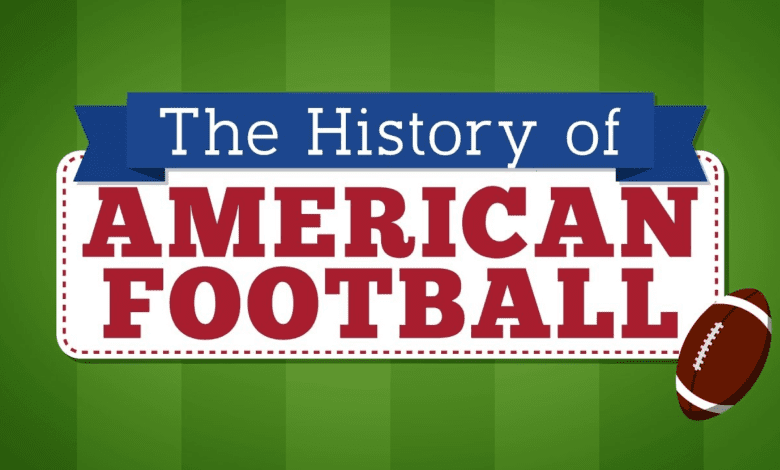The History of American Football

American football has a rich and interesting history that dates back to the 19th century. The sport evolved from various forms of rugby and soccer, primarily played in colleges and universities across the United States. Let’s explore the key milestones and significant developments that shaped the history of American football.
American Football is a sport beloved by millions of fans across the United States. As one of the most popular and lucrative sports in the world, the game has undergone many changes since its inception in the late 19th century. From its early days, when players wore leather helmets and minimal padding, to the modern era, with high-tech gear designed to protect players while maximizing their performance, the game has evolved dramatically.
In this post, we will take a look at the fascinating history of American Football, from its humble beginnings to the present day, and how the sport has become an integral part of American culture. Whether you are a die-hard fan or just curious about the game, this post will give you a comprehensive overview of American Football and its rich history.

The early days of American football
The early days of American football were characterized by a period of experimentation, rule variations, and a lack of standardized regulations. The sport evolved from a combination of rugby and soccer, with different colleges and universities across the United States developing their own versions of the game. Here are some key aspects of the early days of American football:
- Collegiate Beginnings:
- The origins of American football can be traced back to the mid-19th century when college students began playing informal games on their campuses.
- The first documented intercollegiate football game took place on November 6, 1869, between Rutgers and Princeton. The game resembled a mix of soccer and rugby, with 25 players on each team, and the goal was to kick the ball into the opponent’s goal.
- Rule Variations:
- In the early days, there were no standardized rules for football, leading to significant variations in gameplay among different schools.
- Each college had its own set of rules, resulting in a wide range of playing styles. For example, some institutions played with a round ball, while others used an oblong-shaped ball.
- Influence of Rugby:
- Rugby had a significant influence on the development of American football. In the 1870s, rugby-style teams, like the Montreal Football Club, began playing games against American colleges.
- These matches introduced players to the concept of tackling, carrying the ball, and the physical nature of the sport. Some colleges started incorporating elements of rugby into their own football games.
- Walter Camp and Rule Standardization:
- Walter Camp, a player and later a coach at Yale University, played a crucial role in standardizing the rules of American football.
- Camp proposed several rule changes to make the game safer and more organized. His contributions included the introduction of the line of scrimmage, downs, the system of scoring, and the concept of a snap from centre.
- Camp’s ideas gained widespread acceptance and formed the basis for the modern rules of American football.
- Growing Popularity:
- Despite the lack of standardized rules, American football began to gain popularity in colleges and universities across the United States.
- By the late 19th century, football games attracted large crowds, and rivalries between schools fueled enthusiasm for the sport.
- The emergence of college football as a major source of entertainment laid the foundation for the sport’s future growth and development.
The early days of American football were characterized by a period of experimentation and rule variations as different colleges and universities shaped the game to fit their preferences. The efforts of individuals like Walter Camp helped standardize the rules, paving the way for the organized and widely recognized sport that American football has become today.
How the sport evolved in the late 1800s
In the late 1800s, American football underwent significant changes and evolved from its early collegiate origins into a more organized and recognizable sport. Several key developments contributed to the transformation of the game during this period:
- Formation of Football Associations:
- As football gained popularity in colleges, various football associations were formed to establish standardized rules and promote intercollegiate competition.
- The Intercollegiate Football Association (IFA) was established in 1873, consisting of Columbia, Rutgers, Princeton, and Yale. The IFA played a crucial role in shaping the early rules of the game and scheduling matches between member schools.
- Reduction of Players and Rule Standardization:
- In the early days, football games often featured large teams of 25 or more players on each side. This led to chaotic and rough gameplay.
- In the late 1870s and early 1880s, efforts were made to reduce the number of players on the field. The number gradually decreased to 15 players per team, and later to the 11 players that are still used today.
- The rule changes proposed by Walter Camp and adopted by the IFA, such as the line of scrimmage, downs, and the system of scoring, brought standardization and structure to the game.
- Introduction of the Forward Pass:
- In the early years of football, the game primarily focused on running and kicking the ball. Passing the ball forward was not initially allowed.
- In 1906, following concerns about the increasing number of injuries and deaths resulting from the rough nature of the game, new rules were introduced to open up the passing aspect of football.
- The introduction of the forward pass revolutionized the sport, making it more dynamic and strategic. It allowed for more varied offensive tactics and contributed to the growth and popularity of the game.
- Emergence of Rivalries and Traditions:
- During this period, fierce rivalries developed between different colleges and universities, adding excitement and intensity to the sport.
- Traditional rivalries, such as Harvard vs. Yale, Michigan vs. Ohio State, and Army vs. Navy, began to take shape and became an integral part of American football culture.
- These rivalries fueled fan support, increased attendance at games, and helped solidify football’s place in American sports.
- Growth of Spectatorship and Media Coverage:
- In the late 1800s, American football started attracting larger crowds, and the games became major social events on college campuses.
- Newspapers began covering football games, providing fans with scores, updates, and detailed accounts of matches. This increased media coverage helped popularize the sport and generate broader interest.
Overall, the late 1800s marked a period of significant transformation for American football. The reduction in the number of players, rule standardization, the introduction of the forward pass, the development of rivalries, and increased media coverage all contributed to the sport’s evolution and set the stage for its continued growth in the 20th century.

The introduction of helmets and padding
The early days of American football were brutal. Players would tackle each other without any protection, resulting in serious injuries, including fatalities. However, this all changed in the early 1900s with the introduction of helmets and padding.
In 1896, Lafayette College player George “Rose” Barclay was the first football player to wear a head guard in a game. However, it wasn’t until 1915 that helmets began to be used regularly, following a series of fatal injuries from head-on collisions. These early helmets were made of leather and provided minimal protection compared to today’s high-tech helmets.
Shoulder pads were introduced in the 1890s, but it wasn’t until the 1930s that they became standard equipment. The first shoulder pads were made of leather and felt, but by the 1960s, plastic and foam padding became the norm. Today’s shoulder pads are made of advanced materials like Kevlar and are designed to absorb and distribute the impact of a hit.
The introduction of helmets and padding has been critical in reducing the severity of injuries in American football. While injuries still occur, the use of protective gear has undoubtedly helped make the game safer and more enjoyable for players and fans alike.

The creation of the National Football League (NFL)
In 1920, the American Professional Football Conference was founded, which later became the National Football League (NFL). The league was created to bring stability and structure to the sport, which was previously disorganized and fragmented. Eleven teams from four states, including Ohio, Indiana, Illinois, and New York, were the founding members of the NFL. The league quickly grew in popularity, and by the end of its first season, the NFL had attracted more than 400,000 fans to its games.
The NFL continued to expand, and by the 1950s, it had become the nation’s most popular spectator sport. The league’s championship game, the Super Bowl, has become an annual cultural event that attracts millions of viewers around the world. The NFL has also been responsible for many innovations in the sport, including the use of instant replay, the implementation of salary caps, and the creation of the modern draft system. Today, the NFL remains one of the most popular and lucrative sports leagues in the world, with a global fan base that spans continents and cultures.

Key moments in the history of the NFL
The history of the NFL is filled with key moments that have shaped the league into what it is today. One of the biggest moments came in 1958 when the Baltimore Colts defeated the New York Giants in the NFL Championship game in what is now known as “The Greatest Game Ever Played.”
This game brought national attention to the league and helped to grow its popularity.
Another key moment in NFL history was the merger of the NFL and the American Football League (AFL) in 1970. This merger brought together the best teams from both leagues and created a stronger and more competitive league overall.
The NFL has also had its share of controversies throughout its history, such as the 1982 players’ strike and the “Deflategate” scandal involving the New England Patriots in 2015. These controversies have often been a source of public scrutiny, but they have also helped to shape the league and its policies.
In recent years, the NFL has taken steps to address issues such as player safety and social justice. This has included changes to the league’s concussion protocol and initiatives to promote equality and justice for all. These moments in NFL history have helped to make the league what it is today and will continue to shape its future.
The development of modern strategies and tactics
American football has always been a game of strategy and tactics. In the early days, running the ball was the only option, but as the game evolved, so did the strategies and tactics used by teams to gain an advantage over their opponents.
One of the key turning points in the development of modern strategies and tactics was the introduction of the forward pass in 1906. This opened up a whole new dimension of the game and allowed teams to move the ball through the air, rather than just on the ground.
As the game continued to evolve, coaches began to develop new tactics to exploit weaknesses in their opponent’s defences. The development of the T-formation in the 1940s, for example, allowed teams to effectively run the ball up the middle, while the West Coast offence, which emerged in the 1980s, relied heavily on short, precise passes to move the ball down the field.
Today, American football is a highly strategic and tactical game, with coaches and players utilizing a wide range of plays and formations to gain an advantage over their opponents. From the spread offence to the 3-4 defence, the game continues to evolve and change, with new strategies and tactics constantly being developed and refined.
The Impact of Technology on American Football
Technology has had a profound impact on American football, transforming it from a simple game played on dirt fields to a high-tech spectacle that is watched by millions of people around the world.
One of the most significant technological advancements in football has been the development of protective gear, such as helmets and pads, which have greatly reduced the risk of serious injury for players. Today’s football helmets are made of advanced materials like Kevlar and carbon fibre, which provide superior protection while also being lightweight and comfortable for players to wear.
In addition to protective gear, technology has also changed the way football is played and watched. Instant replay technology, for example, allows officials to review controversial calls and make more accurate decisions. This has helped to reduce the number of mistakes made on the field and has led to a fairer and more competitive game.
Another way technology has impacted football is through the use of data analysis and player-tracking systems. NFL teams now use advanced analytics to measure player performance and make strategic decisions about game plans and player personnel. This has led to more efficient and effective gameplay, as coaches are able to make data-driven decisions based on real-time information.
Finally, technology has also transformed the way fans experience football. With the rise of digital media and social networking, fans can now watch games from anywhere in the world and connect with other fans in real time. This has created a global community of football fans who share a passion for the game and who can follow their favourite teams and players with unprecedented ease and convenience. Overall, technology has played a huge role in shaping the modern game of American football, and it will continue to do so for many years to come.
The Future of American Football
American football has come a long way since its inception, with the sport continually evolving and changing to keep up with the times. As we look towards the future, it’s clear that technology will play an increasingly important role in the game.
One area that is already being explored is the use of virtual reality (VR) technology to enhance training and preparation for players. VR can simulate game situations and provide a more immersive experience for players to improve their skills and decision-making abilities.
Another area is the use of wearable technology, such as smart helmets and sensors embedded in players’ uniforms. These devices can provide coaches and medical staff with real-time data on players’ physical performance and health, allowing for better injury prevention and management.
In addition, the use of data analytics and artificial intelligence (AI) can help teams make more informed decisions on everything from game strategy to player recruitment. With the ability to process vast amounts of data quickly and accurately, AI can help teams gain a competitive edge in a sport where every advantage counts.
While it’s impossible to predict exactly what the future of American football will look like, it’s clear that technology will continue to play a major role in shaping the game. As technology continues to advance, we can expect to see even more exciting developments and innovations in the years to come.
NFL Draft Guide: As usual, QBs are coveted in the first round
The Role of American Football in American Culture
American football has become more than just a sport; it has become a part of American culture. It’s a game that brings people together, whether it’s for the Super Bowl or a local high school game. Football has become intertwined with American identity, and many Americans take pride in their team and the sport itself.
Football has also become a way for many Americans to escape from their everyday lives. Fans can lose themselves in the game, forgetting about their problems and immersing themselves in the excitement of the sport. The sport has become a form of entertainment for people of all ages and backgrounds, and it’s not uncommon for families to gather together on Sundays to watch their favourite teams play.
Football has also become a way to showcase American values. The sport is often associated with hard work, dedication, and perseverance. These values are reflected in the players themselves, who train for hours each day and push themselves to their limits on the field. Football players are seen as role models for many Americans, and their dedication to the sport has inspired countless others to pursue their dreams.
In conclusion, American football has become much more than just a game. It has become a part of American culture, reflecting the values and traditions of the country itself. The sport’s popularity shows no signs of waning, and it will continue to be an important part of American society for years to come.
Kyu Blu Kelly: A potential new star for the Buffalo Bills?
How American football has influenced sports around the world
American football has not only become the most popular sport in America but also a global phenomenon. The sport’s popularity has influenced the creation of many other sports around the world, such as rugby and Australian rules football, which are both derived from American football.
The game’s strategy and tactics have also been adopted by other sports, such as basketball, where the concept of running plays and setting up screens are commonly used.
In addition, American football has also influenced the way sports are broadcasted. With the invention of instant replay and the use of specialized camera angles, American football has set the standard for sports broadcasting around the world.
Moreover, the Super Bowl, which is the championship game of the NFL, is now one of the most-watched annual events in the world. It has become a cultural phenomenon that transcends sports and draws in viewers from all walks of life.
In conclusion, American football has had a significant impact on the world of sports and continues to be a driving force in shaping the sports industry globally.






One Comment